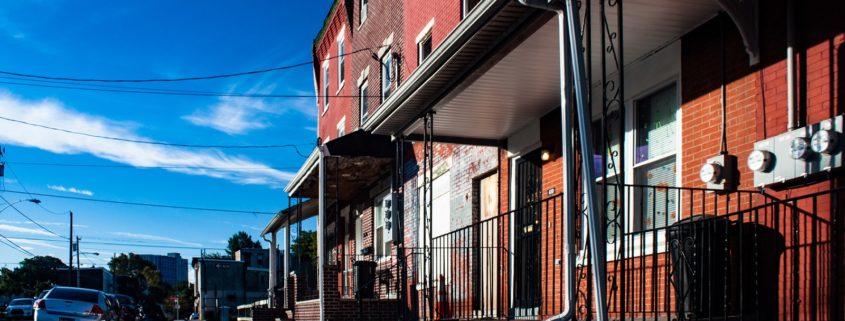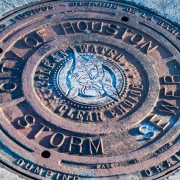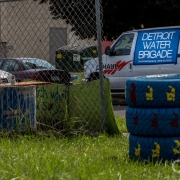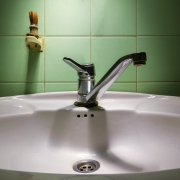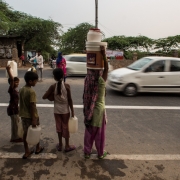Philadelphia Water Rate Experiment Aims to Help Struggling Residents Pay Their Bills
Many applications, and some pain, so far for country’s first income-based water rate.
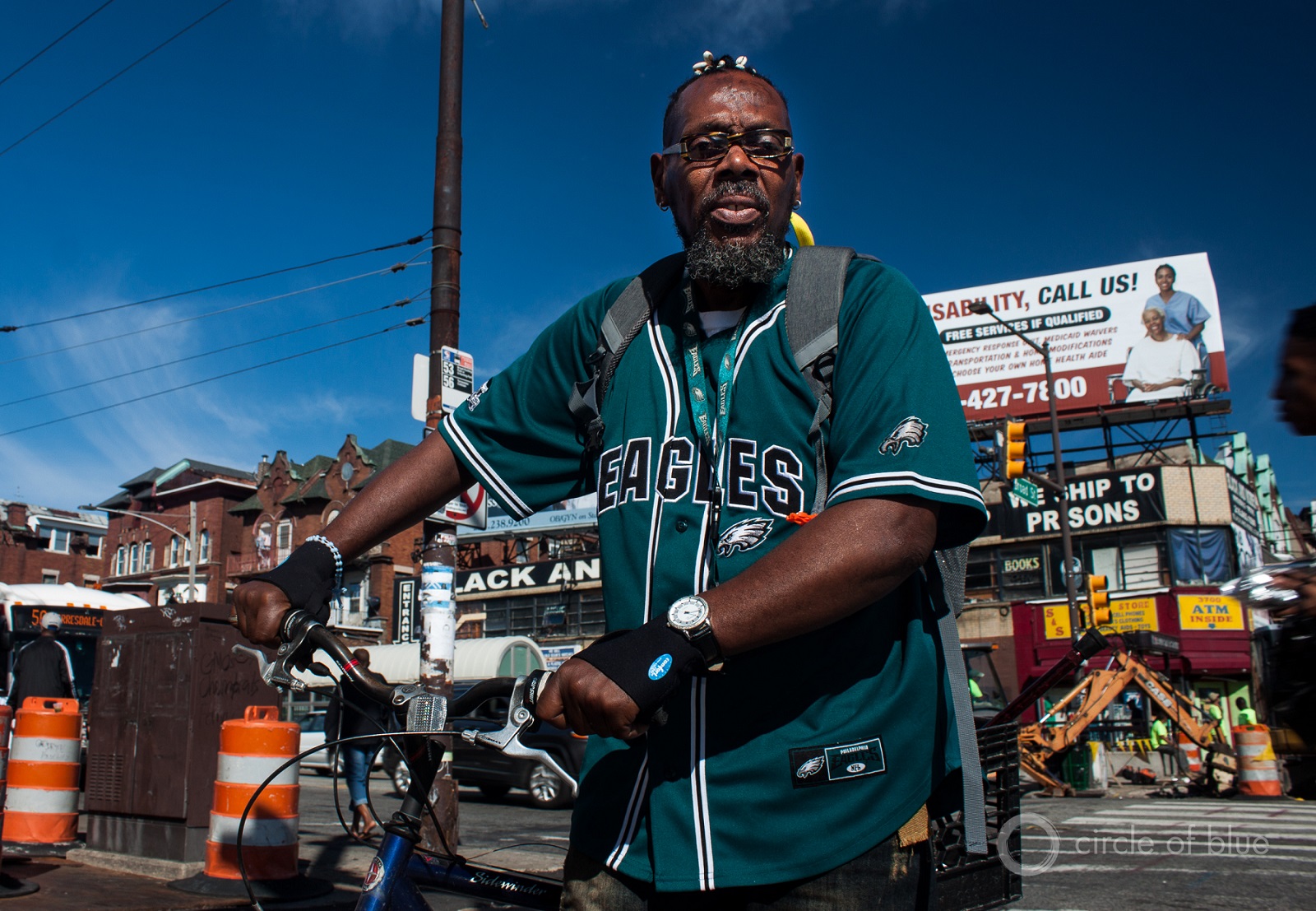
Marvin Edwards, 62, applied for Philadelphia’s new income-based water rate in July, but his application was returned because of missing financial information. Edwards is still waiting for acceptance into the program. Photo © Brett Walton / Circle of Blue
By Brett Walton, Circle of Blue
PHILADELPHIA — On July 1, the Philadelphia Water Department stepped into unexplored territory for a U.S. water utility. The department became the first to set the monthly water, sewer, and stormwater bill for its poorest residents according to their income.
Called the Tiered Assistance Program, or TAP, the groundbreaking aid program was ordered by City Council as a way of matching the cost of household water service with residents’ ability to pay. The need is significant. As many as 60,000 households — one in eight residential customer accounts — meet the eligibility threshold of earning less than 150 percent of the federal poverty line, according to a Water Department estimate.
Philadelphia’s experience with TAP is of keen interest nationally to scholars, public officials, and especially utility leaders, who are walking a narrow line between repairing aged water systems, raising enough revenue to sustain operations, and ensuring that that water bills remain affordable for the poor.
The balancing act has grown more difficult as water rates have climbed faster than inflation. Wage income — the amount earned from work — for the bottom 20 percent went the other direction. It dropped by roughly one percent, measured in today’s dollars, between 1979 and 2016.
Reflecting on the program’s first four months, utility officials are proud that they met the starting deadline and that there have been no bugs in the computer system. About 10,000 applications have been submitted, which is lower than officials had hoped, but still plentiful: it is close to the number that were received in a year under the previous customer aid program.
In the absence of a federal water bill aid program, utilities are being thrust into a social services role for which they have little preparation. Philadelphia officials say that the TAP applications are the first time they are getting detailed financial information about their customers.
Ratepayer advocates, meanwhile, focus on a different number: only one in five applicants has been enrolled. While they hold high expectations for the program and say it is an improvement over previous efforts, advocates and applicants say that the department’s administrative impediments are hindering its potential. Documentation requirements are confusing. Staff is mired in miscommunication. Customers face long wait times on the service call line.
Marvin Edwards is a 62-year-old resident who is one of the 9,858 people, as of October 23, who have submitted TAP applications. Edwards, who lives in North Philadelphia, submitted his application in July but the PWD returned it, saying he needed to include more information about the finances of his daughter, who is staying with him while her apartment building is fumigated.
Edwards recalled a water department technician having to visit his house four times before the technician could get the meter to work. He had to make five or six visits to the water department to submit paperwork, trips made more difficult because of arthritis in his hip and knee that forces him to walk with a cane. Edwards said that discussing his experiences, most of which occurred during an unsuccessful three-year attempt to enroll in the department’s previous aid program, was giving him a headache. “It’s increased my blood pressure dealing with these people,” he told Circle of Blue.
“They need to get out of their own way and let this program be successful,” Josie Pickens, a lawyer at Community Legal Services, which provides legal help to city residents, told Circle of Blue.
A Rate Experiment
Unlike Detroit or Baltimore, cities with declining populations and creaking water systems, Philadelphia’s population has grown almost five percent since 2000 to 1.58 million. Glass high rises and construction cranes sprout at Schuylkill Yards, along the west bank of the Schuylkill River, where city leaders would like to lure retailing giant Amazon and its second headquarters. The Yards are just downstream from Fairmount Water Works, a water delivery system built 200 years ago that earned international praise for its neoclassical design and for providing, what was then, abundant water.
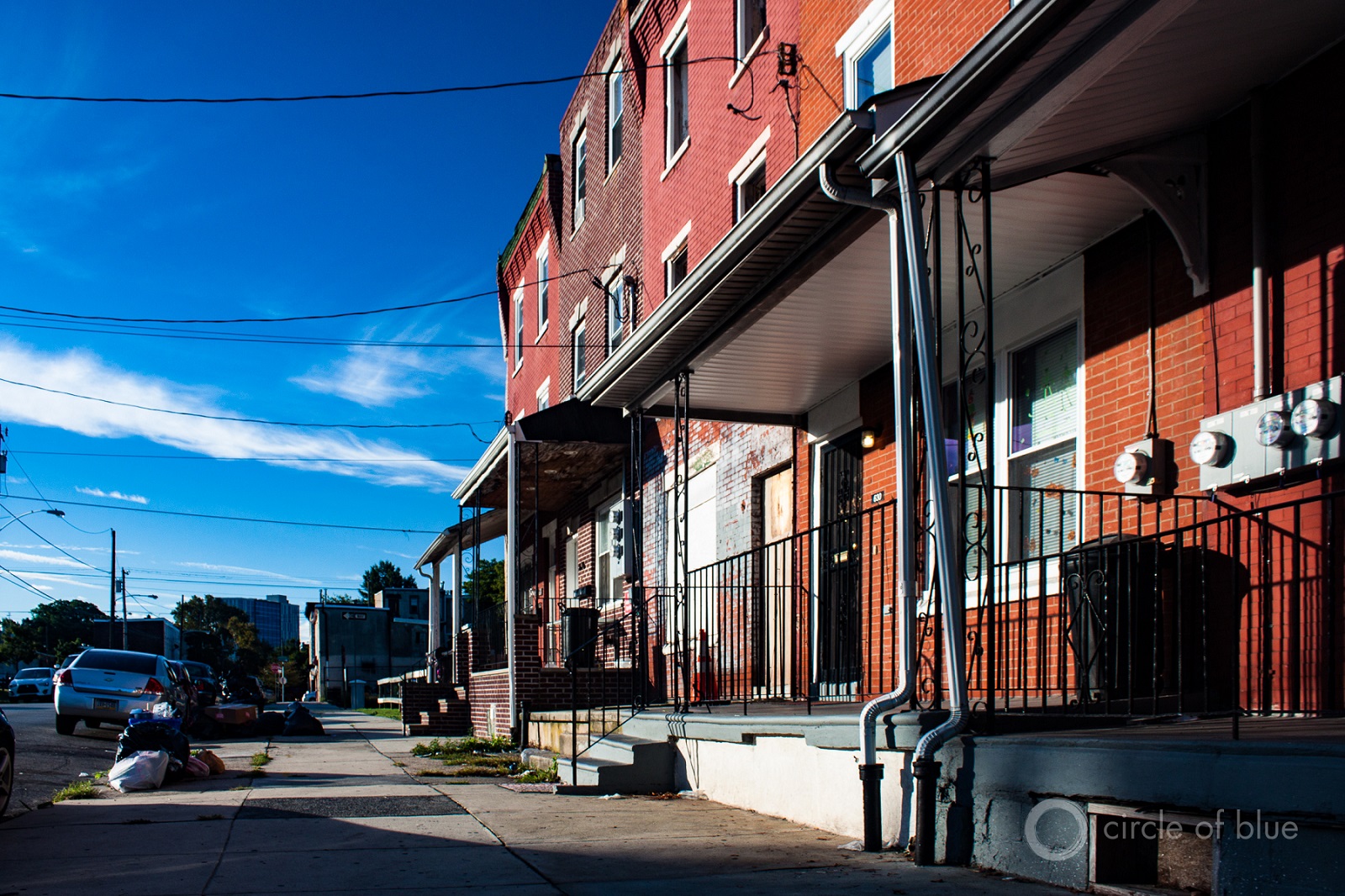
A street in West Philadelphia, one of the city’s poorer neighborhoods. Photo © Brett Walton / Circle of Blue
Philadelphia is also a city of wide socio-economic gaps. It is one of the poorest big cities in the United States, with a poverty rate of 26 percent, more than double the national average. While Rittenhouse Square is threaded with bars and boutiques that cater to the affluent, West Philadelphia, across the river and three miles to the west, is pocked with empty lots and abandoned buildings.
On the western edge of the city is where Angela Foster, 50, lives with her nine-year-old autistic son. Foster received her first TAP bill in September. It was a struggle. Foster spoke of preparing for meetings with the water department as if she were going into battle. “They talk down to you, belittle you like you’re stupid,” Foster said.
Foster is one of the 2,135 people accepted into the program — an acceptance rate of 21 percent. Marvin Edwards is one of the 3,533 people whose application was returned because of incomplete information. The other 40 percent of applications received are still being reviewed. So far there have been no denials.
Now that she is in the program Foster will pay $60 per month, some of which will go toward paying down some $2,000 in past-due balances that accumulated over three years after she lost her job following brain surgery, and lost her child support payments.
Both Foster and Edwards sought help in navigating PWD’s application process with Community Legal Services, a clinic that provides free legal aid to poor Philadelphians. CLS is on the panel that advises the water department on the income-based water rate, and it helped to design the application.
“We want to see this program succeed, that’s why we’ve been so engaged,” Pickens said. Pickens grew up in West Philadelphia and graduated from Temple Law School, a few miles from her office in North Philadelphia.
Both advocates and utility officials say that TAP is better than what came before it. The former customer assistance program required residents to have overdue balances before they could seek financial aid. It was a reactive solution, they said.
“We ran a program that cultivated a culture of ‘get behind and we’ll help you,’” Michelle Bethel, the deputy commissioner in charge of the Water Revenue Bureau told Circle of Blue. “This program opens the door to a lot more people.”
Bethel reckons the gulf between eligible households and applications submitted can be explained by the calendar. The former customer assistance program, called WRAP, expires at the end of the year for people already enrolled. Those customers might not switch until they are required, Bethel said. “The sense of urgency may not be there for people not yet at the end of the plan,” she explained.
But applications still may not rise in January. That is because the water department does not shut off water from January 1 to March 31. Procrastinators could conceivably wait until spring to submit their TAP forms.
“We would love to be inundated with applications, to have more response,” Bethel said. But considering that the water department processed about 11,000 applications per year under the former aid program, having nearly 10,000 in four months “is not bad,” Bethel said.
The average bill for residents accepted into TAP is $19.84 per month, compared to the system-wide average of $70.87, according to water department figures. One-fifth of TAP enrollees are paying the minimum, which is $12 per month. There are three TAP tiers: households earning up to 50 percent of federal poverty level pay two percent of monthly income; those between 51 percent and 100 percent pay 2.5 percent; and those between 101 percent and 150 percent pay three percent. For those accepted in the program, bills do not change according to use.
Customer Service Frequently a Headache
The TAP application functions as a life raft for household whose water is at risk of being shut off because of missed payments. As soon as a customer requests an application, the shut off proceeding is paused, Bethel notes. Customers accepted into the program cannot have water shut off, even if they have large past-due balances, as long as they make payments. Acceptance also halts foreclosure proceedings due to water debt, which is a reason that Edwards is eager to enroll. The city initiated foreclosure on his house in April 2016.
One issue that has not yet been settled is the fate of past-due balances. Penalties such as late fees are forgiven for TAP enrollees who make 24 payments in full. The principal remains, however, but does not accrue. As of 2016, the department had $170 million in commercial and residential back payments that were at least one year past due.
Advocates for the income-based rate argued that the program could pay for itself or at least break even if it increased the payment rate and reduced the administrative cost of trying to claw back past-due balances. They point to long-running income-based rates for electric power utilities as examples that this type of program is effective. Bethel, however, said that TAP has not been around long enough for those financial calculations. “It’s too soon to talk about savings,” she said.
The department budgeted $18 million to implement TAP, a sum that includes 22 new staff. With additional employees, Pickens thinks the department should be vetting applications faster.Advocates have run into problems as well. Justin Hollinger is a second-year student at Drexel University Law School who works with the university’s Community Lawyering Clinic on water access cases. Hollinger told Circle of Blue that he hears different answers from different employees about what documents are needed as proof of residency or income. Wait times for a call center response are “extraordinary,” he said, usually taking six hours to receive a return call.
“It’s the definition of a bureaucracy,” Pickens said, echoing these concerns. “One hand is not talking to the other.”
These experiences seem to be widely shared. J.D. Power, most commonly known for its car ratings, also conducts an annual national water utility customer satisfaction survey. In the 2017 edition, the Philadelphia Water Department ranked in the bottom quarter of 87 large utilities in the survey.
Water department officials say that they are aware of the concerns. “We’ve heard these things and we’re trying to improve,” said Joanne Dahme, department spokeswoman, mentioning staff trainings and a rating system to identify ineffective employees. A visit to the customer service counter at the Water Revenue Bureau did reveal a staff person helping people with the kiosks that print out tickets reserving a place in line.
Finding the World in Philadelphia
Others in the city look at TAP and see in the program society’s inability to address deep-rooted inequalities and economic trends.
Bernard Reed, president of the Workers Benefit Council, which advocates for the working poor, points to failing water systems in Flint, Detroit, and elsewhere. He connects water shutoffs and poverty in American cities and towns to international activism around the United Nations’ sustainable development goals which aim for water and sanitation for all, hard as it may be, by 2030. Aid will only go so far in achieving that goal, he said.
“Until the government works to end poverty TAP will only be able to do so much,” Reed told Circle of Blue. “But it’s a step toward getting access.”
Brett writes about agriculture, energy, infrastructure, and the politics and economics of water in the United States. He also writes the Federal Water Tap, Circle of Blue’s weekly digest of U.S. government water news. He is the winner of two Society of Environmental Journalists reporting awards, one of the top honors in American environmental journalism: first place for explanatory reporting for a series on septic system pollution in the United States(2016) and third place for beat reporting in a small market (2014). He received the Sierra Club’s Distinguished Service Award in 2018. Brett lives in Seattle, where he hikes the mountains and bakes pies. Contact Brett Walton

